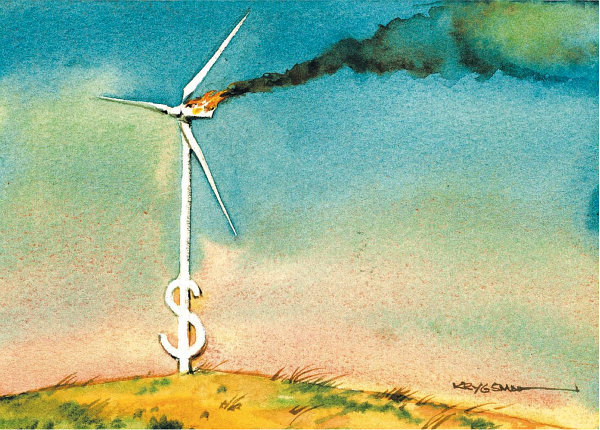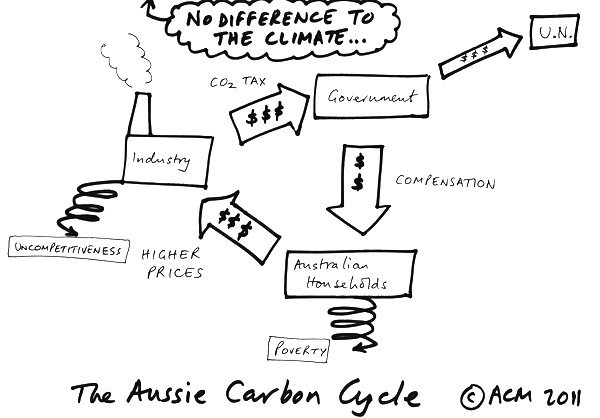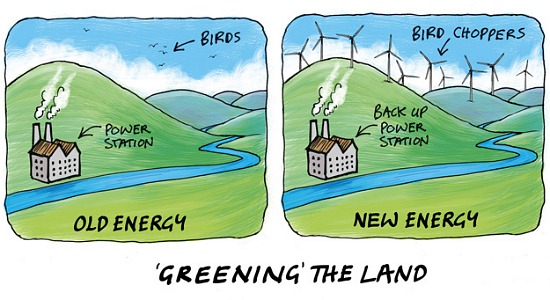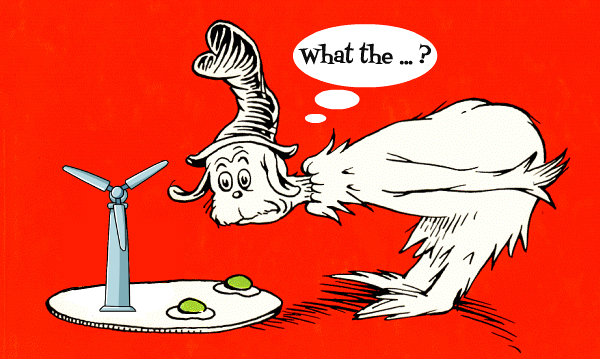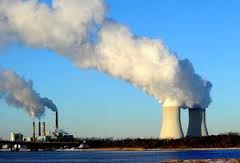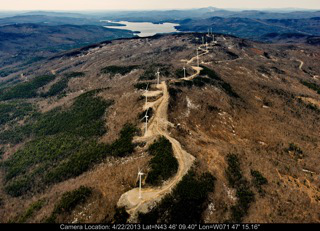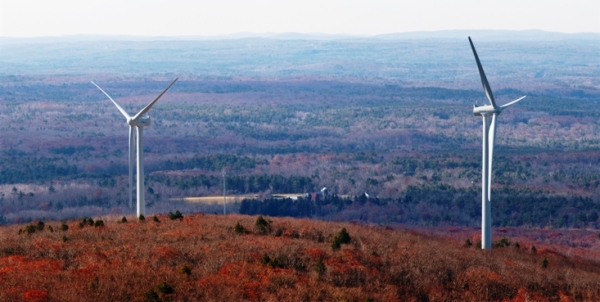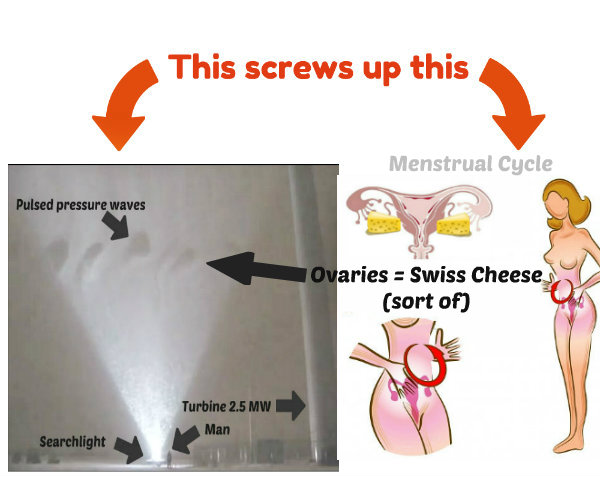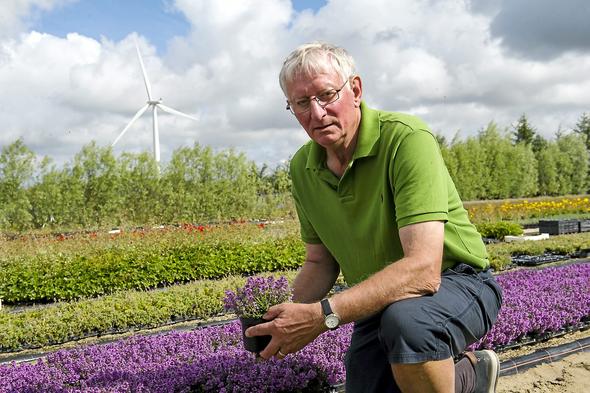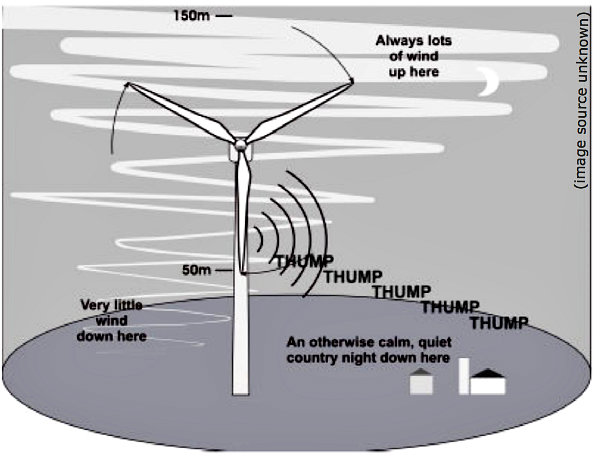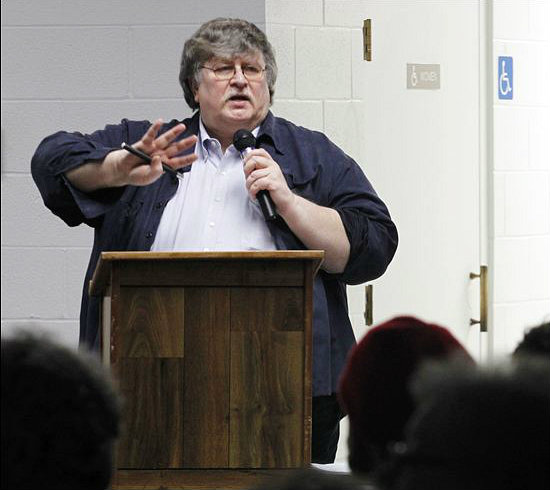.
Editor’s note: The following is a letter Dr. Pierpont wrote to a group in Turkey that’s trying to keep wind turbines out of its community. (Click here for a PDF.) We are told the wind developer has been ordered by a court to stop building the turbines. Being Turkey, the developer has brazenly ignored the court order — and is proceeding full steam ahead. (So much for the “rule of law.”)
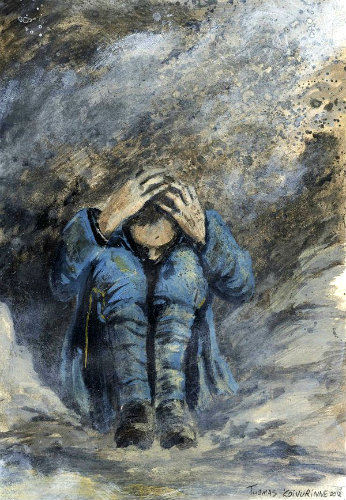
.
To: Ms. Kabadayi-Whiting, Cesme, Turkey
From: Nina Pierpont, MD, PhD
Regarding: The proper siting of wind turbines
Date: June 30, 2014
.
I write to you at the request of Madeleine Kura, who tells me the lovely, seaside town of Cesme is about to get half a dozen 3 MW industrial wind turbines built on the edge of town, a mere 500 m from people’s homes. (I’m told that at least one of the turbines will be 300 m from a school.) Furthermore, all this construction will be in hilly terrain.
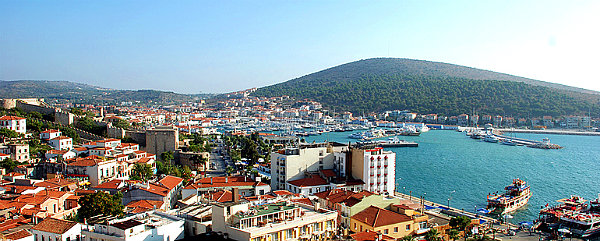
Let me explain, clinically, why this is a bad idea. In 2009 I published what was then the definitive study of health effects caused by wind turbine infrasound on people living within 2 km of industrial turbines. The book, “Wind Turbine Syndrome: A Report on a Natural Experiment” (K-Selected Books), included 60 pages of raw data in the form of case histories (using case cross-over studies), demonstrating that living in proximity to wind turbines dys-regulates the inner ear vestibular organs controlling balance, position, and spatial awareness. Effectively, sufferers experience symptoms of sea-sickness, along with several related pathologies.

It turns out all this has been well known since the 1980s, when the US Department of Energy commissioned a report on wind turbine health effects — the report subsequently published by physicist Dr. N D Kelley and his colleagues at the Solar Research Institute in Golden, Colorado, bearing the title, “A Methodology for Assessment of Wind Turbine Noise Generation,” Transactions of the American Society of Mechanical Engineers, v. 104 (May 1982), pp. 112-120.
In this paper we have presented evidence to support the hypothesis that one of the major causal agents responsible for the annoyance of nearby residents by wind turbine noise is the excitation of highly resonant structural and air volume modes by the coherent, low-frequency sound radiated by large wind turbines.
Further, there is evidence that the strong resonances found in the acoustic pressure field within rooms [in people’s homes] . . . indicates a coupling of sub-audible energy [infrasound] to human body resonances at 5, 12, and 17-25 Hz, resulting in a sensation of whole-body vibration (p. 120).
I discovered the same thing in my research. What Kelly et al. refer to as a “sensation of whole-body vibration,” I refer to as Visceral Vibratory Vestibular Disturbance (VVVD): “The internal quivering, vibration, or pulsation and the associated complex of agitation, anxiety, alarm, irritability, tachycardia, nausea, and sleep disturbance together make up what I refer to as Visceral Vibratory Vestibular Disturbance (VVVD)” (Wind Turbine Syndrome, p. 59).

Five years later, Dr. Kelley gave a follow-up paper at the Windpower ’87 Conference & Exposition in San Francisco, titled “A Proposed Metric for Assessing the Potential of Community Annoyance from Wind Turbine Low-Frequency Noise Emissions.” Just so you understand the terminology, “emissions” means “noise & vibration.” And the term “low frequency” includes infrasound. And the antiseptic phrase “community annoyance” is code for Wind Turbine Syndrome — except the name had not been coined in1987. (I created it decades later.) Kelley’s research once again had been funded by the US Department of Energy, Contract No. DE-AC02-83CH10093.
We electronically simulated three interior environments resulting from low-frequency acoustical loads radiated from both individual turbines and groups of upwind and downwind turbines. . . .
Experience with wind turbines has shown that it is possible . . . for low-frequency acoustic noise radiated from the turbine rotor to interact with residential structures of nearby communities and annoy the occupants. . . .
The modern wind turbine radiates its peak sound power (energy) in the very low frequency range, typically between 1 and 10 Hz [i.e., infrasound]. . . .
Our experience with the low-frequency noise emissions from a single, 2 MW MOD-1 wind turbine demonstrated that . . . it was possible to cause annoyance within homes in the surrounding community with relatively low levels of LF-range [low frequency range] acoustic noise. An extensive investigation of the MOD-1 situation revealed that this annoyance was the result of a coupling of the turbine’s impulsive low-frequency acoustic energy into the structures of some of the surrounding homes. This often created an annoyance environment that was frequently confined to within the home itself (p. 1, emphasis in original).
I am attaching a copy of Kelley’s 1987 paper.
Besides my research, which pretty much duplicates Kelley’s, there is the work of Dr. Alec Salt, Professor of Otolaryngology in the School of Medicine at Washington University (St. Louis, Missouri), where he is director of the Cochlear Fluids Research Laboratory. Professor Salt is a highly respected neuro-physiologist specializing in inner ear disorders and in particular the mysteries of the cochlea.

Prof. Salt’s research dovetails with mine and with Dr. Kelley’s. For many years, acousticians and noise engineers have vigorously maintained that “if you can’t hear it, it can’t hurt you.” That is to say in the case of wind turbines, “If you can’t hear the low-frequency noise in the infrasound range, it can’t hurt you.” (lnfrasound, by definition, is noise below the hearing threshold, typically pegged at 20 Hz and lower. People feel infrasound in various parts of the body, though typically they cannot hear it.) In any case, Professor Salt and his colleagues have demonstrated conclusively, definitively, that infrasound does in fact disturb the very fine hair cells of the cochlea.
With this discovery, one of the main arguments advanced by the wind energy industry — namely, that wind turbine infrasound was too low to be harmful to people, since they could not hear it — was demolished. Prof. Salt has proven that, “If you can’t hear it, it can still harm you.”
This past winter, Professor Salt and his colleague, Professor Lichtenhan, published “How Does Wind Turbine Noise Affect People?” Acoustics Today, v. 10 (Winter 2014), pp. 20-28. The following is a lengthy excerpt:
The essence of the current debate is that on one hand you have the well-funded wind industry (1) advocating that infrasound be ignored because the measured levels are below the threshold of human hearing, allowing noise levels to be adequately documented through A-weighted sound measurements; (2) dismissing the possibility that any variants of wind turbine syndrome exist (Pierpont 2009) even when physicians (e.g., Steven D. Rauch, M.D. at Harvard Medical School) cannot otherwise explain some patients’ symptoms; and (3) arguing that it is unnecessary to separate wind turbines and homes based on prevailing sound levels.
On the other hand, you have many people who claim to be so distressed by the effects of wind turbine noise that they cannot tolerate living in their homes. Some move away, either at financial loss or bought-out by the turbine operators. Others live with the discomfort, often requiring medical therapies to deal with their symptoms. Some, even members of the same family, may be unaffected. Below is a description of the disturbance experienced by a woman in Europe we received a few weeks ago as part of an unsolicited e-mail.
From the moment that the turbines began working, I experienced vertigo-like symptoms on an ongoing basis. In many respects, what I am experiencing now is actually worse than the ‘dizziness’ I have previously experienced, as the associated nausea is much more intense. For me the pulsating, humming, noise that the turbines emit is the predominant sound that I hear and that really seems to affect me.
While the Chief Scientist [the person who came to take sound measurements in her house] undertaking the measurement informed me that he was aware of the low frequency hum the turbines produced (he lives close to a wind farm himself, and had recorded the humming noise levels indoors in his own home) he advised that I could tune this noise out and that any adverse symptoms I was experiencing were simply psychosomatic. . . .
Given the knowledge that the ear responds to low frequency sounds and infrasound, we knew that comparisons with benign sources were invalid and the logic to A-weight sound measurements was deeply flawed scientifically. . . .
From this understanding we conclude that very low frequency sounds and infrasound, at levels well below those that are heard, readily stimulate the cochlea. Low frequency sounds and infrasound from wind turbines can therefore stimulate the ear at levels well below those that are heard. . . .
No one has ever evaluated whether tympanostomy tubes alleviate the symptoms of those living near wind turbines. From the patient’s perspective, this may be preferable to moving out of their homes or using medical treatments for vertigo, nausea, and/or sleep disturbance. The results of such treatment, whether positive, negative, would likely have considerable scientific influence on the wind turbine noise debate….
Another concern that must be dealt with is the development of wind turbine noise measurements that have clinical relevance. The use of A-weighting must be reassessed as it is based on insensitive, Inner Hair Cell (IHC)-mediated hearing and grossly misrepresents inner ear stimulation generated by the noise. In the scientific domain, A-weighting sound measurements would be unacceptable when many elements of the ear exhibit a higher sensitivity than hearing. The wind industry should be held to the same high standards. Full-spectrum monitoring, which has been adopted in some reports, is essential. . . .
Given the present evidence, it seems risky at best to continue the current gamble that infrasound stimulation of the ear stays confined to the ear and has no other effects on the body. For this to be true, all the mechanisms we have outlined (low frequency-induced amplitude modulation, low frequency sound-induced endolymph volume changes, infrasound stimulation of type II afferent nerves, infrasound exacerbation of noise-induced damage and direct infrasound stimulation of vestibular organs) would have to be insignificant. We know this is highly unlikely and we anticipate novel findings in the coming years that will influence the debate.
I suspect you are beginning to get a clear picture of the problem — and why I’m writing to you.
The typical symptoms of what is now known worldwide as Wind Turbine Syndrome are: sleep disturbance, headache, tinnitus (ringing or buzzing in the ears), ear pressure, dizziness (a general term that includes vertigo, light-headedness, sensation of almost fainting, etc.). nausea, visual blurring, tachycardia (rapid heart rate), irritability, problems with concentration and memory, and panic episodes associated with sensations of internal pulsation or quivering which arise when awake or asleep.

Does everybody living near wind turbines experience Wind Turbine Syndrome? By no means! What I discovered is that people with (a) motion sensitivity, (b) migraine disorder, (c) the elderly (50 years and older), (d) inner ear damage, and (e) autistic children and adults — all these are at statistically significant high risk.
The solution is simple: industrial wind turbines must be set back, well away from people’s homes, schools, places of work, and anywhere else people regularly congregate. In my 2009 report, I recommended a minimum setback of 2 km in level terrain. Studies done around the world since then have persuaded me that 2 km is not sufficient, especially in hilly or mountainous terrain — as with Cesme. In Cesme’s case, setbacks should be more on the order of 5 km or greater.
Hence my alarm when notified by Ms. Kura that Cesme is considering 500 m (or less) setbacks. This is wholly inadequate. I guarantee that, unless the setbacks are increased substantially, there will be numerous victims of Wind Turbine Syndrome.
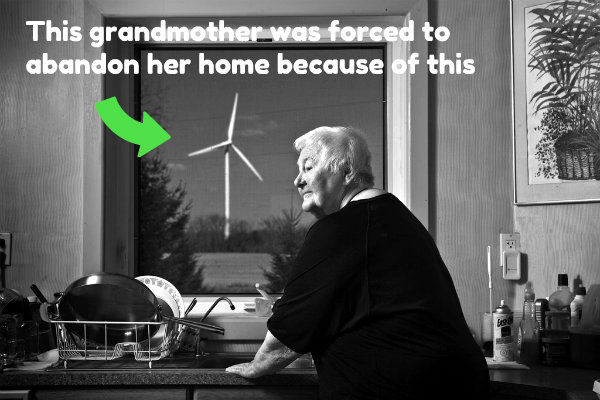
There’s more. Dr. Salt referred to Dr. Steven Rauch, above. Dr. Rauch, a physician, is the Medical Director of Harvard Medical School’s renowned Clinical Balance and Vestibular Center, part of the Massachusetts Eye & Ear Infirmary. Dr. Rauch was recently interviewed by The New Republic:
Dr. Steven Rauch, an otologist at the Massachusetts Eye and Ear Infirmary and a professor at Harvard Medical School, believes WTS [Wind Turbine Syndrome] is real. Patients who have come to him to discuss WTS suffer from a “very consistent” collection of symptoms, he says. Rauch compares WTS to migraines, adding that people who suffer from migraines are among the most susceptible to turbines. There’s no existing test for either condition but “Nobody questions whether or not migraine is real.”
“The patients deserve the benefit of the doubt,” Rauch says. “It’s clear from the documents that come out of the industry that they’re trying very hard to suppress the notion of WTS and they’ve done it in a way that [involves] a lot of blaming the victim” (“Big Wind Is Better Than Big Oil, But Just as Bad at P.R.,” by Alex Halperin in The New Republic, June 16, 2014).
Dr. Rauch made a similar statement to ABC News last fall.

I met with Dr. Rauch in Cambridge, Mass., several years ago. He has read my “Wind Turbine Syndrome” book. You’re welcome to contact him for his clinical opinion. Notice, he actually treats WTS victims, and furthermore his specialty is neuro-otology — precisely the clinical specialty appropriate to WTS, since WTS is mainly a vestibular disorder. (You might consider Dr. Rauch the “pope” of vestibular disease.)

Shifting gears, a group of mechanical engineers at the University of Minnesota recently mapped the airflow turbulence patterns of a 2.5 MW wind turbine. Their technique was ingenious: “A large searchlight with custom reflecting optics generated a two-dimensional light sheet next to the 130-m-tall wind turbine for illuminating the snow particles in a 36-m-wide by 36-m-high area.” They literally mapped the vortices being hurled off the turbine blades, using a blizzard (!) as a kind of background screen.
Visit this website to see and savor the dramatic results.
Click open the video and notice the pulsed pressure waves from the blades — punching holes, as it were, in the swirling snow. (You can also watch the video on YouTube. That is, until the wind energy lobby manages to get it taken down.)
Think of volleys of acoustic artillery, much of it in the low frequency and infrasound range. Imagine the residents of Cesme being bombarded by this day and night.
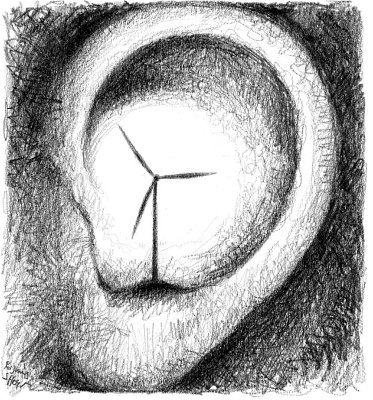
You are looking at the huge, pulsed, sound pressure waves responsible for Wind Turbine Syndrome. (The Minnesota group published their article: Jiarong Hong et al., “Natural Snowfall Reveals Large-Scale Flow Structures in the Wake of a 2.5-MW Wind Turbine,” Nature Communications, vol. 5, no. 4216 (June 2014).
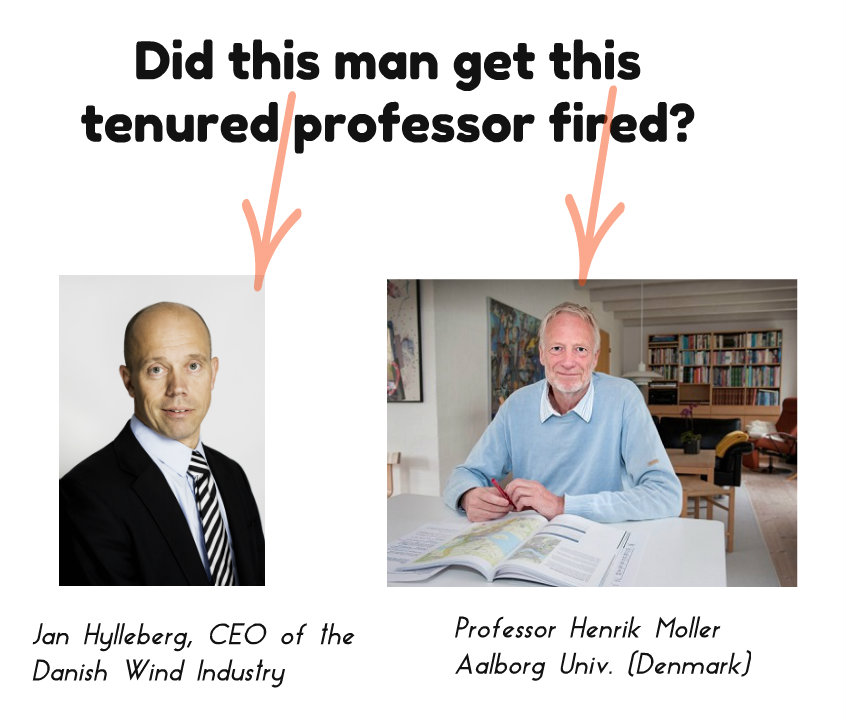
Ms. Kura tells me the turbines destined for Cesme are 3 MW. Several years ago, the noted Danish noise engineer, Professor Henrik Moller at Aalborg University, published a paper titled “Low-Frequency Noise from Large Wind Turbines,” Journal of the Acoustical Society of America, vol. 129, no. 6 (June 2011), pp. 3727-3744. Moller and his colleague, Christian Sejer Pedersen, demonstrated that “the larger the turbine, the greater the ILFN (infrasound and low frequency noise) produced.” The following is the abstract of their paper. (Professor Moller was summarily fired this spring. Click here for the story, which has the wind industry’s fingerprints all over it.)
As wind turbines get larger, worries have emerged that the turbine noise would move down in frequency and that the low-frequency noise would cause annoyance for the neighbors. The noise emission from 48 wind turbines with nominal electric power up to 3.6 MW is analyzed and discussed.
The relative amount of low-frequency noise is higher for large turbines (2.3–3.6 MW) than for small turbines (2 MW), and the difference is statistically significant. The difference can also be expressed as a downward shift of the spectrum of approximately one-third of an octave.
A further shift of similar size is suggested for future turbines in the 10 MW range.
Due to the air absorption, the higher low-frequency content becomes even more pronounced when sound pressure levels in relevant neighbor distances are considered.
Even when A-weighted levels are considered, a substantial part of the noise is at low frequencies and, for several of the investigated large turbines, the one-third octave band with the highest level is at or below 250 Hz.
It is thus beyond any doubt that the low-frequency part of the spectrum plays an important role in the noise at the neighbors.
Given all of the above, you can see why I am concerned for the residents of Cesme.
A final word. The clinical literature, including publications by the World Health Organization on health effects from infrasound exposure, typically use the word that Dr. Kelley used in his reports to the US Department of Energy — “annoyance.” It’s really not an appropriate word. It vastly understates the sickness caused by infrasound exposure. (A mosquito bite is an annoyance. Wind turbine infrasound, on the other hand, triggers a debilitating cascade of illnesses whose features I enumerated, above.)
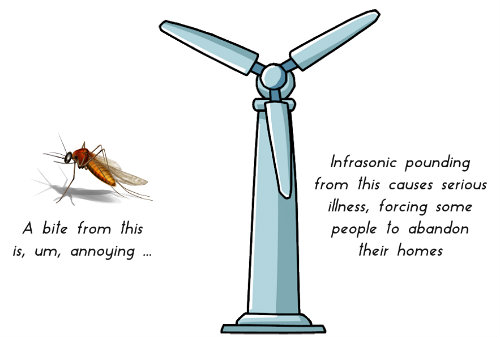
In medicine, we clinicians are morally bound to exercise what’s called the “precautionary principle.” That is, if we don’t know for certain that a procedure is harmless, we are obliged to exercise extreme caution in performing the procedure, in this instance building industrial wind turbines — which are well-known to produce impulsive (i.e., amplitude-modulated) infrasound — near people’s homes. This is, after all, common sense.
For decades, the wind industry flatly denied their turbines produced infrasound. It took monumental efforts by people like me to debunk this fallacy. Wind industry advocates likewise argued that only downwind turbines created noise, that is, low-frequency noise. Dr. Kelley and his research team effectively debunked that falsehood, in the articles referred to above. Finally, the wind industry clung to the fiction that, “If you can’t hear it, it can’t hurt you.” Professor Salt deflated that one.

It’s time to recognize that the global wind industry has hidden behind a series of (what turned out to be) falsehoods. Their untruths have been exposed and corrected in the published clinical and scientific literature, as shown above.
There is no excuse for building wind turbines in proximity to people’s homes.



